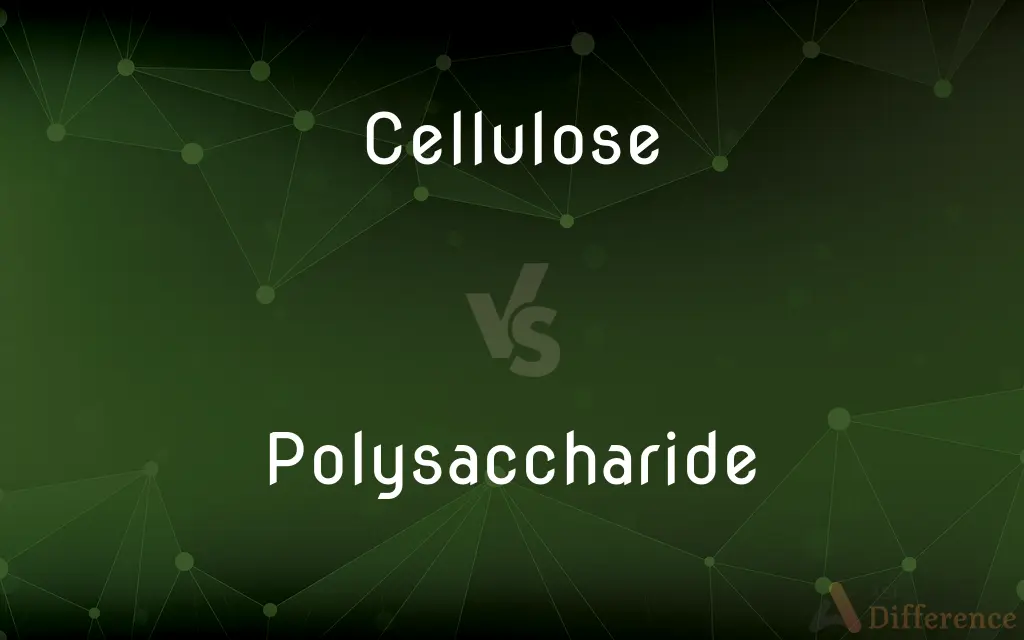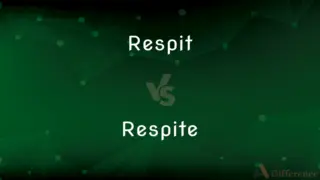Cellulose vs. Polysaccharide — What's the Difference?
By Tayyaba Rehman — Updated on September 27, 2023
"Cellulose is a complex carbohydrate forming plant cell walls. Polysaccharide is a carbohydrate, e.g., starch or cellulose, composed of several sugar molecules."

Difference Between Cellulose and Polysaccharide
Table of Contents
ADVERTISEMENT
Key Differences
Cellulose and Polysaccharide are terms often encountered in biochemistry and they relate to complex carbohydrates, but they are used to describe different concepts. Cellulose is a specific type of polysaccharide. It is a complex carbohydrate that constitutes the main component of plant cell walls and is crucial for the structure and stability of plants. It’s an organic compound composed of glucose units linked by β-1,4-glycosidic bonds, rendering it insoluble in water and resistant to digestion in most organisms.
Polysaccharide, on the other hand, is a general term used for carbohydrates formed by the linkage of multiple monosaccharide molecules through glycosidic bonds. Polysaccharides play various roles in organisms; they can serve as energy storage, like starch and glycogen, or as structural components, like cellulose and chitin. They exhibit diversity in their structure and function, based on the type of monosaccharides involved and the nature of their bonds.
While Cellulose is exclusively a structural component in plants, providing rigidity to plant cells, Polysaccharides have a broader range of functions and occurrences, appearing in various forms in plants, animals, and humans. Cellulose’s unique structural characteristic, consisting of linear chains of glucose molecules, contrasts with the varied structural forms of polysaccharides, which can be branched or linear and may contain different types of monosaccharide units.
Cellulose is not just a significant structural component but also has industrial applications, utilized in the production of paper, textiles, and various derived products. The broader category, Polysaccharides, includes entities with varied applications, ranging from energy storage to serving as additives in food industries. The utilization of these entities is vast, encompassing numerous domains such as food, medicine, and manufacturing.
In essence, while Cellulose is a specific structural polysaccharide found in plants, Polysaccharides represent a wider class of complex carbohydrates with varied structures, functions, and occurrences in living organisms.
ADVERTISEMENT
Comparison Chart
Definition
Specific type of polysaccharide
General term for complex carbs
Function
Structural component in plants
Diverse: structural, energy storage
Occurrence
Mainly in plant cell walls
In plants, animals, and humans
Structure
Linear chains of glucose molecules
Can be branched or linear
Application
Paper, textiles
Food, medicine, various industries
Compare with Definitions
Cellulose
Organic compound resistant to digestion in most organisms.
Most animals lack enzymes to break down cellulose.
Polysaccharide
Exhibits diversity in structure and function.
Different polysaccharides have different structures and functions in organisms.
Cellulose
Main component of plant cell walls.
Cellulose provides structural support to plants.
Polysaccharide
Composed of different types of monosaccharide units.
A polysaccharide may be composed of various monosaccharide units linked together.
Cellulose
Insoluble fiber aiding in digestion.
Cellulose adds bulk to the diet, aiding digestion.
Polysaccharide
Carbohydrate composed of multiple sugar molecules.
Starch is a type of polysaccharide used as an energy store in plants.
Cellulose
Utilized in the production of paper and textiles.
Cellulose is processed to make paper products.
Polysaccharide
Complex molecule serving various functions in organisms.
Glycogen is a polysaccharide that stores energy in animal cells.
Cellulose
Cellulose is an organic compound with the formula (C6H10O5)n, a polysaccharide consisting of a linear chain of several hundred to many thousands of β(1→4) linked D-glucose units. Cellulose is an important structural component of the primary cell wall of green plants, many forms of algae and the oomycetes.
Polysaccharide
Can be structural like cellulose or storage like starch.
Polysaccharides have diverse roles, from structure to energy storage.
Cellulose
A polysaccharide, (C6H10O5)n, that is composed of glucose monomers and is the main constituent of the cell walls of plants. It is used in the manufacture of numerous products, including paper, textiles, pharmaceuticals, and insulation.
Polysaccharide
Polysaccharides (), or polycarbohydrates, are the most abundant carbohydrate found in food. They are long chain polymeric carbohydrates composed of monosaccharide units bound together by glycosidic linkages.
Cellulose
A complex carbohydrate that forms the main constituent of the cell wall in most plants and is important in the manufacture of numerous products, such as paper, textiles, pharmaceuticals, and explosives.
Polysaccharide
A carbohydrate (e.g. starch, cellulose, or glycogen) whose molecules consist of a number of sugar molecules bonded together.
Cellulose
(organic compound) A polysaccharide containing many glucose units in parallel chains.
Polysaccharide
Any of a class of carbohydrates, such as starch and cellulose, consisting of a number of monosaccharides joined by glycosidic bonds.
Cellulose
Consisting of, or containing, cells.
Polysaccharide
(carbohydrate) A polymer made of many saccharide units linked by glycosidic bonds.
Cellulose, starches, and complex carbohydrates, such as glycogen, are common polysaccharides in biology.
Cellulose
Consisting of, or containing, cells.
Polysaccharide
Any of a class of carbohydrates whose molecules contain chains of monosaccharide molecules
Cellulose
The substance which constitutes the essential part of the solid framework of plants, of ordinary wood, cotton, linen, paper, etc. It is also found to a slight extent in certain animals, as the tunicates. It is a carbohydrate, (C6H10O5)n, isomeric with starch, and is convertible into starches and sugars by the action of heat and acids. When pure, it is a white amorphous mass. See Starch, Granulose, Lignin.
Unsized, well bleached linen paper is merely pure cellulose.
Cellulose
A polysaccharide that is the chief constituent of all plant tissues and fibers
Cellulose
Complex carbohydrate composed of glucose units.
Cellulose is a polymer made up of glucose molecules.
Common Curiosities
Are Polysaccharides complex carbohydrates?
Yes, polysaccharides are complex carbohydrates composed of multiple sugar molecules.
Is Cellulose the main component of plant cell walls?
Yes, cellulose is the primary structural component of plant cell walls.
Is Cellulose resistant to digestion in most organisms?
Yes, most organisms cannot digest cellulose as they lack the necessary enzymes.
Is Cellulose a type of Polysaccharide?
Yes, cellulose is a specific type of polysaccharide.
Can Polysaccharides store energy?
Yes, some polysaccharides like starch and glycogen store energy.
Do Polysaccharides have varied structures?
Absolutely, polysaccharides exhibit a variety of structures, being branched or linear.
Does Cellulose have industrial applications?
Absolutely, cellulose has numerous industrial applications including in textiles and food products.
Can Polysaccharides be used as food additives?
Yes, some polysaccharides are used as food additives due to their properties like viscosity.
Can Polysaccharides be found in humans?
Yes, polysaccharides such as glycogen are present in humans, storing energy.
Is Cellulose used in the production of paper?
Yes, cellulose is crucial in the production of paper and various other products.
Is Cellulose insoluble in water?
Yes, cellulose is insoluble in water due to its β-1,4-glycosidic bonds.
Are all Polysaccharides structural?
No, polysaccharides can have diverse roles, including structural and energy-storage functions.
Does Cellulose contribute to dietary fiber?
Yes, cellulose is a major component of dietary fiber, aiding in digestion.
Is Cellulose a linear chain of glucose molecules?
Yes, cellulose consists of linear chains of glucose molecules connected by β-1,4-glycosidic bonds.
Can Polysaccharides be synthesized by animals?
Yes, animals synthesize polysaccharides like glycogen for energy storage.
Share Your Discovery

Previous Comparison
Abutting vs. Adjacent
Next Comparison
Respit vs. RespiteAuthor Spotlight
Written by
Tayyaba RehmanTayyaba Rehman is a distinguished writer, currently serving as a primary contributor to askdifference.com. As a researcher in semantics and etymology, Tayyaba's passion for the complexity of languages and their distinctions has found a perfect home on the platform. Tayyaba delves into the intricacies of language, distinguishing between commonly confused words and phrases, thereby providing clarity for readers worldwide.














































